Abstract
Part-baked rye bread with and without Ca-propionate (0.2 g/100 flour) were baked for 10, 15, 20 minutes at 230°C and stored at refrigerator temperature (4°C) for 10, 20, 30 days then second-baked for 5, 10, 15 minutes at the same temperature to give an oven-fresh end product. The effect of antimicrobial additive (Ca-propionate), part-baking, storage in refrigerator and rebaking on quality parameters such as yield of volume and crumb softness, water activity and pasting properties of rye bread crumb was evaluated. Addition of Ca-propionate increased bump area, while yield of volume and softness values of rye bread crumb decreased. The increase in initial baking time caused a decrease in the pasting temperature, water activity, and softness value and an increase in the bump area and viscosity of the rebaked bread crumb. Bump area and pasting temperature of rebaked rye bread crumb increased with longer (intermediate storage) time, while viscosity, yield of volume, water activity, and softness values decreased. A strong negative correlation was observed between pasting temperature and other parameters, which are bump area, peak viscosity, holding end viscosity, cooling end viscosity, and softness value for rye bread that was rebaked after part-baked and storing at refrigerator temperature. The re-baking rye bread after part-baking for 10 and 15 minutes and storage for 7, 14, and 21 days at refrigerator temperature gave softer crumb than the control group.
INTRODUCTION
Bakery products typically have by a relatively short shelf-life, and their deterioration is caused by the fast developing staling process. This term covers a number of physicochemical changes leading to loss of freshness and worsening of bread quality.[Citation1–3] Bread staling is a complex process and although the exact mechanism still remains unclear, since starch is the major constituent in the bread crumb, the physical changes accompanying the retrogradation of starch have been suggested to be the main cause of bread staling.[Citation4,Citation5] The search for efficient methods of preventing undesirable changes produced by staling has been pursued for many years in order to prolong the shelf-life of such products. The investigations conducted up to now have revealed that the staling process can be slowed down by adding to the dough certain natural components and enzymatic preparations.[Citation6]
The partial baking of the bread and its further storage at refrigerator temperatures is an effective way for delaying the staling process of the baked goods.[Citation7,Citation8] Part-baked bread is a method of bread manufacturing involving two stages of baking with an intermediate storage. First, the proofed dough pieces are baked under the defined oven conditions into partially baked products with the minimum crust coloration and the maximum moisture retention.[Citation9] Next, the products are refrigerated to the ambient temperature, wrapped, and stored until the final re-baking at the point of sale. Part-baking has a great market potential since this process provides an opportunity to supply fresh baked bread with a simple baking stage at retail locations. The core objective of offering part-baked breads to consumers is to facilitate all day availability of fresh breads.[Citation10,Citation11]
In general, rye could be exploited more efficiently in new types of cereal products due to its positive health effects. Rye bread made from rye whole meal or lower extraction rye flour is an important constituent of the diet in many countries. Rye bread has good shelf-life and its structure is based, to a limited extend, on a gluten matrix. Rye bread has a high dietary fiber, which can substantially reduce the risk of coronary heart disease. It is also suggested that phytoestrogens (lignans) present in rye might act as natural cancer-preventive compounds.[Citation12,Citation13] Rye bread is produced less than wheat bread, because it excessively is not consumed. Rye bread consumers could not purchase the rye bread when they want. Therefore, part-baked rye bread can be developed to prove consumers with oven fresh bread at any desired time with a simple bake-off stage.
Amylography was employed by several researchers[Citation14–16] to study the pasting characteristics of aging bread crumbs. Peak viscosity of bread crumb slurries was reported to decrease with staling of the crumbs. The minor peak and the bump were attributed to the interactions of solubilised amylose with four lipids, mainly polar lipids. In the cooling stage, a transition of amylose from random coil to lipid-inclusion helices may be responsible for the observed increase in viscosity. Subsequent crystallization of the helices probably resulted in a decrease in viscosity, thus forming a bump. Sometimes a plateau, attributed to melting of retrograded amylopectin, was observed before the onset of the viscosity increase. The purpose of the present paper was to investigate the effects of initial baking period and storage in refrigerator on softness and pasting properties of part-baked rye breads, to examine the relationship between bread crumb softness and pasting properties of bread crumb and to prolong shelf-life of rye bread with the part-baking method.
MATERIALS AND METHODS
Materials
Wheat flour (12.75% water, 12.18% protein, 0.55% ash, 34.22% gluten, 62.00% water absorption), and whole rye flour (11.25% water, 13.45% protein, 2.17% ash), fresh yeast, and salt were obtained from local market. Calcium propionate was purchased from Fluka Inc.
Baking of Bread Samples
The rye bread formula was as follows: 600 g of white wheat flour, 400 g of whole rye flour, 665 g of tap water, 30 g of compress yeast, 15 g of salt, and 2 g of Ca-propionate. The flours (wheat and rye), water and other ingredients were mixed for 2 minutes. After a resting time of 15 minutes at 30°C (75% RH), the dough was divided into 160 g potions that were manually molded, rested (10 min, at 30°C, 75% RH) and panned by shaping before proofing for 35 minutes at 30°C (75% RH). Then, for production of part-baked rye bread (baking phase I), the loves were baked at 230°C for 10, 15, 20 minutes. After initial baking process, breads were cooled for 1 hour and then packaged in 20 × 30 cm double folded nylon (polyethylene) pouches and stored for 7, 14, 21 days at refrigerator temperature (4°C). After storage, the part-baked rye breads were re-baked in the same oven (230°C) for 15, 10, 5 minutes. Baking periods of the part-baked breads were completed to baking time of the control breads (25 min) by rebaking process (baking phase II).
Physical and Chemical Analysis
Protein, ash, and moisture contents were determined according to AACC Approved Methods 46–12, 08–01, and 44–15A, respectively.[Citation17] Wet gluten content were determined according to ICC Standard Method 137–1[Citation18] using the Glutomatic 2200 system (Perten, Huddinge, Sweden). Water absorption of flour was determined by the Farinograph instrument.[Citation15] Breads were weighed within one hour after baking, volumes of breads were measured using colza grains and specific volumes were calculated.[Citation19] Water activity (aw) of bread crumbs were determined using the electrohigrometric method proposed by Münzing.[Citation20] Protein and ash were expressed on a dry weight basis. All determinations were carried out in triplicate.
Pasting Properties of Bread Crumb
The pasting properties of rye bread crumb were examined with the Brabender Amylograph (model 8101, Brabender, Duisburg, Germany).[Citation16,Citation21] Samples of bread crumb were collected 12 hours after taking away of the bread from the oven. The bread crumbs were removed from bread, sliced and stored in polyethylene bags at 30°C at a relative humidity of 85–90%. The freeze-dried crumb was ground on a Wiley mill to pass through a 60-mesh sieve. The Brabender Amylograph was used to examine the pasting properties of the bread crumb. The sample (55 g) was suspended in 350 ml of distilled water by agitation in a Warring Blender at low speed for 1 minute. The suspension was poured into the amylograph bowl, and the blender was rinsed with 100 ml of additional distilled water. The crumb suspension was heated uniformly from 30 to 95°C, held at 95°C for 15 minutes, and then cooled uniformly to 50°C. The information obtained from the amylograph curve included plateau, peak, pasting temperature, viscosity (peak, holding and, cooling end), and bump area, (the area under the amylograph curve during the cooling cycle, as measured with a planimeter).
Measurement of Bread Crumb Softness Value (Staling Rate)
Staling rate of bread was measured by compressibility with a penetrometer (PNR 10—Penetrometer).[Citation22] Breads were stored in sealed polyethylene bags at room temperature (20°C) at 12 hours after removal of the bread from the oven. For crumb softness two slices of 23 mm were taken from the centre of the bread and each sample was compressed in five spots by a weigh of 54.6 g for 5 seconds. The compression spots were marked by holes on the four corners and center of a 6 × 6-cm cardboard template placed on the cut surface of each sample. Data for five points from each loaf were averaged to give the compressibility, measured with a penetrometer units (1 penetration unit (PU) = 0.1 mm).
Statistical Analysis
All the experiments were carried out in triplicate and in two different trials. Statistical evaluations were performed with the SPSS/package (a completely randomized design procedure by SPSS).[Citation23] Differences between data were tested using the Duncan's range test (P < 0.05).
RESULTS AND DISCUSSION
Results of Analyses for the Part-Baked Rye Breads Without Storage
Pasting characteristics of rye bread crumb baked at different baking times (10, 15, 20, 25 min.) and with and without Ca-propionate are shown in . Although paste viscosity patterns were similar, viscosity of the rye bread crumbs slightly decreased with length of baking time both with and without Ca-propionate. Among part-baked rye breads, rye bread baked for 25 minutes had the lowest viscosity. This could be explained due to the high baking time causing more degradation of starch in rye bread.[Citation24] The data obtained from Amylograph, yield of volume, aw, and softness of rye bread crumb is given in . In generally, the addition of Ca-propionate slightly decreased yield of volume, aw and softness value of rye bread crumb. The increase in baking time slightly increased pasting temperature and bump area of rye bread crumb both and without Ca-propionate while viscosity (peak, holding end, cooling end) was decreased by baking time.
Figure 1 Effect of baking time (10, 15, 20, 25 min at 230°C) on pasting behavior of rye bread crumbs with (below) and without Ca-propionate (above) (C: control group).
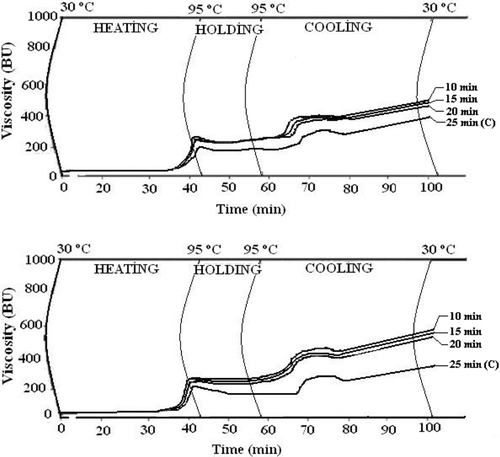
Table 1 Rye bread crumb amylograph characteristics, volume yield, aw and softness values of breads at different baking times (mean ± S.D).
Analyses for the Rye Bread Rebaked During Storage
The effects of antimicrobial additive (Ca-propionate) on amylogram data (pasting temperature, bump area, viscosity values), aw, yield of volume and softness value of rebaked rye bread after part-baked and stored at refrigerator temperature (+ 4°C) are shown in . The addition of Ca-propionate resulted in a significant increase (P < 0.01) in the bump area and a decrease (P < 0.01) in yield of volume and softness value of rye bread. Similar results were reported by Karaoğlu,[Citation24] in which Ca-propionate caused to an increase in bump area and a decrease in softness value of part-baked white pan bread crumb. A commonly known as bump area appears in the amylograms during the cooling stage. The bump area has been associated with the extent of the formation of amylose-lipid complex during cooling phase due to the absence of the lipid fraction and other component. High bump area is connected to a softened effect of the bread crumb.[Citation16,Citation25] However, in this research, softness of rye bread crumb decreased as bump area increased. Therefore, it was concluded that the decrease in softness value of rye bread crumb might be mainly due to decrease in volume of rye bread rather than bump area. The addition of Ca-propionate had no significant effects on pasting temperature, viscosity and aw of rye bread crumb.
Table 2 Effect of antimicrobial additive (Ca-propionate) on pasting properties, volume yield, aw and softness of rye bread crumb (mean ± S.D)Footnote a.
The amylograms readings, yield of volume, water activity and softness values of the crumbs of rebaked bread after various durations of part-baking and storage and formulated with and without antimicrobial additive (Ca-propionate) are shown in . The increase in initial baking time caused to a significant decrease (P < 0.01) in the pasting temperature, water activity and softness value of rye bread crumb, and an increase (P < 0.01) in bump area, holding end and cooling end viscosity. Our results agree with previous studies,[Citation24] in that initial baking time increased bump area, viscosity and decreased pasting temperature, aw and softness of rebaked white pan bread crumb. The degree of gelatinization and pasting properties of bread crumb depends mainly on moisture and baking time but also temperature during baking.[Citation14,Citation26]
Table 3 Effect of initial baking time on pasting properties, volume yield, aw and softness of rye bread crumb (mean ± S.D)Footnote a .
Pasting temperature of rye bread crumb rebaked after part-baking and storage was significantly increased (P < 0.01) by intermediate storage of part baked rye bread (). However, pasting temperature did not significantly change during the 7, 14, and 21 days of intermediate storage. This may be explained by the fact that sugar arising from degradation of starch occurred during the intermediate storage period, which increases pasting temperature in the crumb amylogram. It is reported that pasting temperature increased as sugar levels increased.[Citation27,Citation28] Bump area of rebaked rye breads crumb did not significantly different (P < 0.01) on seventh and fourteenth days of intermediate storage while control group rye breads presented larger areas than rye bread crumb stored at all storage times. It is reported that bump area decreased with increasing storage time. High bump area are associated to high concentration of amylose-lipid complex, and it is connected to a softened effect of the bread crumb.[Citation15,Citation25]
Table 4 Effect of intermediate storage time on pasting properties, volume yield, aw and softness of rye bread crumb (mean ± S.D)Footnote a .
In general, the increase in storage time of part-baked rye breads resulted in decrease peak, holding end and cooling end viscosities. Our results agree with previous studies[Citation14,Citation16] in that viscosity values of bread crumbs decreased continuously during storage of bread. Storage time of part-baked rye breads caused to almost the same effect on yield of volume, water activity and softness value. Since part-baked process increased the yield of volume and water content of rye bread crumb, softer crumbs were obtained. The highest crumb softness value and yield of volume increased up to 44.6 PU and 383.6 cm3 when part-baked breads were stored for 7 days at refrigerator temperature, respectively.
The bump area and peak viscosity of rebaked rye bread after part-baking for 10, 15, and 20 minutes, and intermediate storage decreased (P < 0.01) sharply in the 7-day old rye bread, but increased (P < 0.01) less thereafter, as shown in and , respectively. The 10 minutes prebaking time displayed the lowest bump area and peak viscosity, while the 20 minutes prebaking time exhibited the highest bump area and peak viscosity at all initial storage times.
Figure 2 Effect of initial baking times (10 min (o), 15 min (□), 20 min (▵)) on changes in bump area of rye bread crumb during storage. (C: control group).
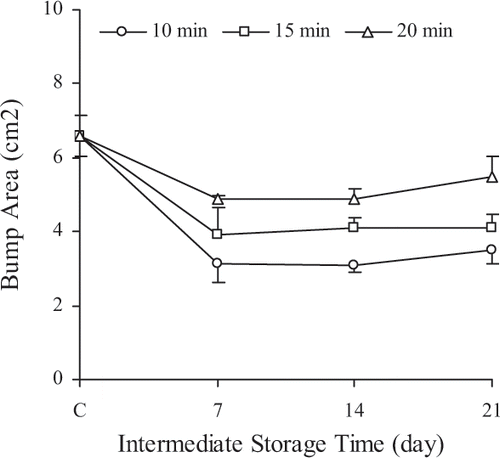
Figure 3 Effect of initial baking times (10 min (o), 15 min (□), 20 min (▵)) on changes in peak viscosity of rye bread crumb during storage. (C: control group).
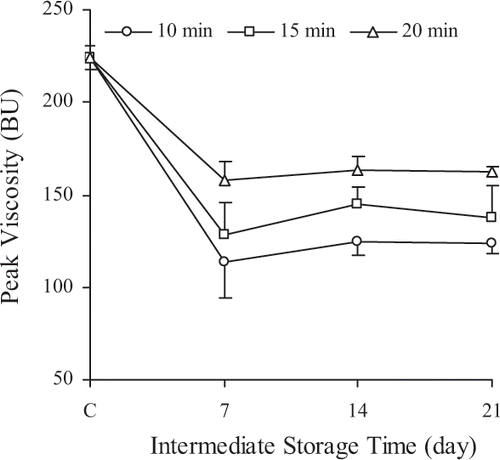
Water activity of crumb of rebaked rye bread decreased (P < 0.01) gradually during storage period (). This decrease in water activity was more pronounced in rye bread crumb which had 20 minute initial baking time. The same variation was also observed in softness values of rye bread crumb (). The increase of initial storage period decreased softness value of rye bread crumb, less noticeably with 10 minute initial baking time than 15 and 20 minute initial baking time. However, 10 minute initial baking at all initial storage periods and 15 minute initial baking on 7th and 14th day of refrigerator temperature storage gave crumb softness same as control group breads or softer.
Figure 4 Effect of initial baking times (10 min (o), 15 min (□), 20 min (▵)) on changes in water activity of rye bread crumb during storage. (C: control group).
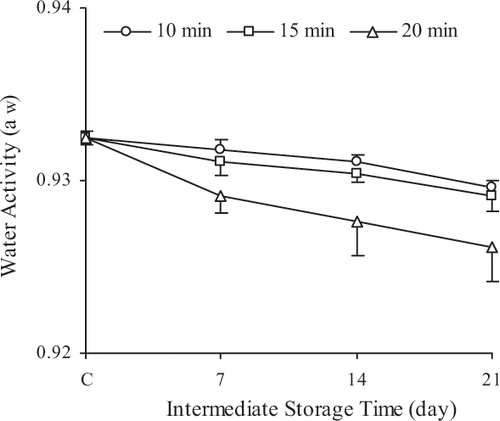
Figure 5 Effect of initial baking times (10 min (o), 15 min (□), 20 min (▵)) on changes in bread crumb softness of rye bread crumb during storage. (C: control group).
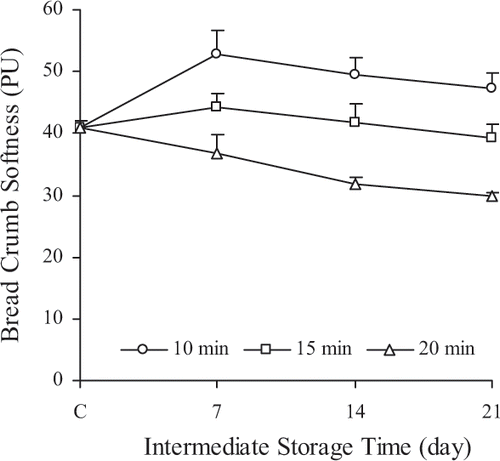
During this study, pasting properties of crumb such as pasting temperature and viscosity and bump area, and water activity, yield of volume and softness value were used to assess the extent of staling in rebaked rye bread after part-baking and intermediate storage. The correlation coefficients between some of the important parameters like bump area, peak, holding end and cooling end viscosity, water activity, softness and yield of volume for rye bread are presented in . As can be seen from , a strong negative correlation was observed between pasting temperature and other parameters which are bump area, peak viscosity, holding end viscosity, cooling end viscosity, and softness value for rye bread. As shown in , bump area, peak, holding end and cooling end viscosities produced highly significant positive correlation among themselves. However, softness value of rye bread crumb produced a highly negative correlation with these parameters. Softness values of rye breads crumbs produced significant positive correlation with water activity of bread crumbs. Similar results were reported by Karaoğlu[Citation24] and Xu et al.[Citation16] No significant correlation could be found between yield of volume and other parameters.
Table 5 Correlation coefficients of amylogram readings, softness, yield of volume, and water activity of rye bread crumb.
CONCLUSION
Part-baking, storage and rebaking processes significantly affected pasting properties and crumb softness of rye bread. Addition of Ca-propionate had slight effect on the amylograms readings. Changes in initial part-baking time and storage time of part-baked breads contributed significantly to the amylograms readings, yield of volume, water activity, and softness of crumbs of rebaked rye bread. An inverse relationship between crumb softness value and amylogram readings such as pasting temperature, bump area, peak, holding end, and cooling end viscosities of rye bread crumbs were found and attributed to the changes in baking time and storage period. Because part-baked rye breads were stored at refrigerator temperature (4°C), molding and rope spoilage did not occur in the bread without Ca-propionate addition. The re-baking rye bread after part-baking for 10 and 15 minutes and storage of 7, 14, and 20 days at refrigerator temperature gave softer crumb than the control group. Regarding the crumb softness, the short initial baking time or the long rebaking time is recommended for rye bread baked in two-step baking process (rebaking after part-baking and storage).
REFERENCES
- D'Appolonia , B.L. and Morad , M.M. 1981 . Bread Sstaling . Cereal Chem. , 58 ( 3 ) : 186 – 190 .
- He , H. and Hoseney , R.C. 1990 . Changes in Bread Firmness and Moisture during Long-term Storage . Cereal Chem. , 67 : 603 – 605 .
- Hebeda , R.E. , Bowles , L.K. and Teague , W.M. 1990 . Developments in Enzymes for retarding Staling of Baked Goods . Cereal Foods World , 35 : 453 – 457 .
- Seow , C.C. and Teo , C.H. 1996 . Staling of Starch Based Products: A comparative Study by Firmness and Pulsed NMRmeasurements . Starch , 48 ( 3 ) : 90 – 93 .
- Martin , M.L. and Hoseney , R.C. 1991 . A mechanism of bread firming. II. Role of Starch Hydrolyzing Enzymes . Cereal Chem. , 68 ( 5 ) : 503 – 507 .
- Miroslaw , F. and Krzysztof , S. 2002 . Effect of Prebaking and Frozen Storage on The Sensory Quality and Instrumental Texture of Bread . J Sci Food Agric. , 82 : 1268 – 1275 . [CROSSREF]
- Leuschner , R.G.K. , O'Callaghan , M.J.A. and Erendt , E.K. 1997 . Optimization of Baking Parameters of Part-baked and Rebaked Irish Brown Soda Bread by Evaluation of Some Quality Characteristics . Int. J. Food Sci. Tech. , 32 : 487 – 493 .
- Fik , M. and Surowka , K. 2002 . Effect of Prebaking and Frozen Storage on The Sensory Quality and Instrumental Texture of Bread . Journal of the Science of Food and Agriculture , 82 ( 11 ) : 1268 – 1275 . [CROSSREF]
- Grundy , J.G. , Hebeda , R.E. and Zobel , H.F. 1996 . Baked Goods Freshness: Technology, Evaluation, and Inhibition of Staling , 189 – 202 . New York : Marcel Dekker .
- Vulicevica , I.R. , Abdel-Aalb , E-S.M. , Mittalc , G.S. and Lub , X. 2004 . Quality and Storage Life of Par-Baked Frozen Breads . Lebensm.-Wiss. Technol. , 37 : 205 – 213 . [CROSSREF]
- Karaoglu , M.M. 2005 . Microbiological Characteristics of Part-baked White Pan Bread During Storage . Int. J. Food Properties , 8 ( 2 ) : 355 – 365 . [CROSSREF]
- Bushuk , W. 2001 . Rye Production and Uses Worldwide . Cereal Foods World , 46 ( 2 ) : 70 – 73 .
- Hansen , H.B. , Anderson , M.F. , Nielsen , M.M. , Larsen , M.M. , Bach Knudsen , K.E. , Meyer , A.S. , Christensen , L.P. and Hansen , A. 2001 . Changes in Dietary Fiber, Phenolic Acids and Activity of Endogenous Enzymes During Rye Bread-making . European Food Research and Tech. , 214 ( 1 ) : 33 – 42 .
- Yasunaga , T. , Bushuk , W. and Irvine , G.N. 1968 . Gelatinization of Starch During Bread-baking . Cereal Chemistry , 45 : 269 – 279 .
- Xu , A. , Chung , O.K. and Ponte , J.G.J. 1992 . Bread Crumb Amylo-graph Studies. I. Effects of Storage Time, Shortening, Four Lipids, and Surfactants . Cereal Chemistry , 69 ( 5 ) : 495 – 501 .
- Morad , M.M. and D'Appolonia , B.L. 1980 . Effect of Surfactants and Baking Procedure on Total Water-soluble and Soluble Starch in Bread Crumb . Cereal Chem. , 57 ( 2 ) : 141 – 144 .
- Anonymous . 1995 . Approved methods of the American Association of Cereal Chemists , 9th , USA : AACC .
- ICC Standard No. 137 . 2001 . “ Mechanical determination of the wet gluten content of wheat flour (Glutomatic) ” . In The Standard Methods of the ICC Edition
- Lee , C.C. , Hoseney , R.C. and Varriona-Martson , E. 1982 . Development of A Laboratory-scale Single-Stage Cake Mix . Cereal Chem. , 59 : 389 – 392 .
- Münzing , K. 1987 . Wasser ein Wichtiger Physikalllisc her Qualitatsfaktor bei Getreide . Getreide Mehl und Brot , 41 ( 12 ) : 362
- Xu , A. , Ponte , J.G. J. and Chung , O.K. 1992 . Bread Crumb Amylo-graph Studies. II. Cause of Unique Properties . Cereal Chemistry , 69 ( 5 ) : 502 – 507 .
- Maleki , M. , Hoseney , R.C. and Mattern , P.J. 1980 . Effects of Loaf Volume, Moisture Content, and Protein Quality on The Softness and Staling Rate of Bread . Cereal Chem. , 57 ( 2 ) : 138 – 140 .
- SPSS . 1996 . SPSS for Windows Release 10.01 , Chicago, IL : SPSS Inc. .
- Karaoğlu , M.M. Effect of Baking Procedure and Storage on The Pasting Properties and Staling of Part-baked and Rebaked White Pan Bread Crumb . Int. J. Food Properties , To appear in
- Rojas , J.A. , Rosell , C.M. and Benedito de Barber , C. 1999 . Pasting Properties of Different Wheat Four-hydrocolloid Systems . Food Hydrocolloids , 13 : 27 – 33 . [CROSSREF]
- Faridi , H. A. and Rubenthaler , G.L. 1984 . Effect of Baking Time and Temperature on Bread Quality, Starch Gelatinization and Staling of Balady Bread . Cereal Chem. , 61 ( 2 ) : 151 – 154 .
- D'Appolonina , B.L. and Macarthur , L.A. 1974 . Effect of Ingredients on Continuous Bread Crumb Pasting Characteristics . Cereal Chem. , 51 ( 2 ) : 195 – 202 .
- Karaoğlu , M.M. , Kotancilar , H.G. and Çelik , I. 1998 . The Obtain of Modified Starch and Usage in The Baking Products . Atatürk Univ. J. Fac. of Agric. , 29 ( 2 ) : 359 – 368 .